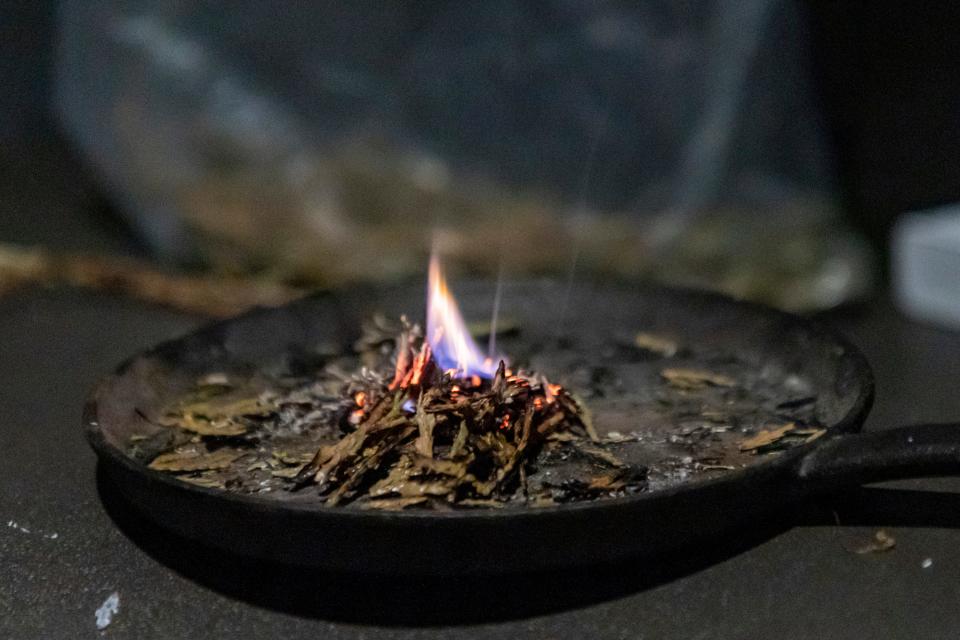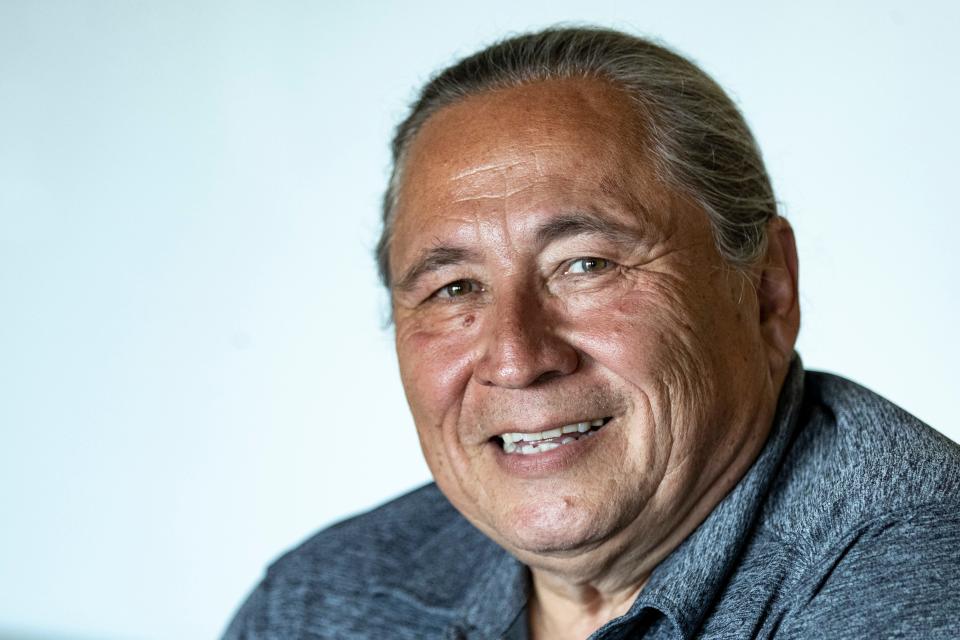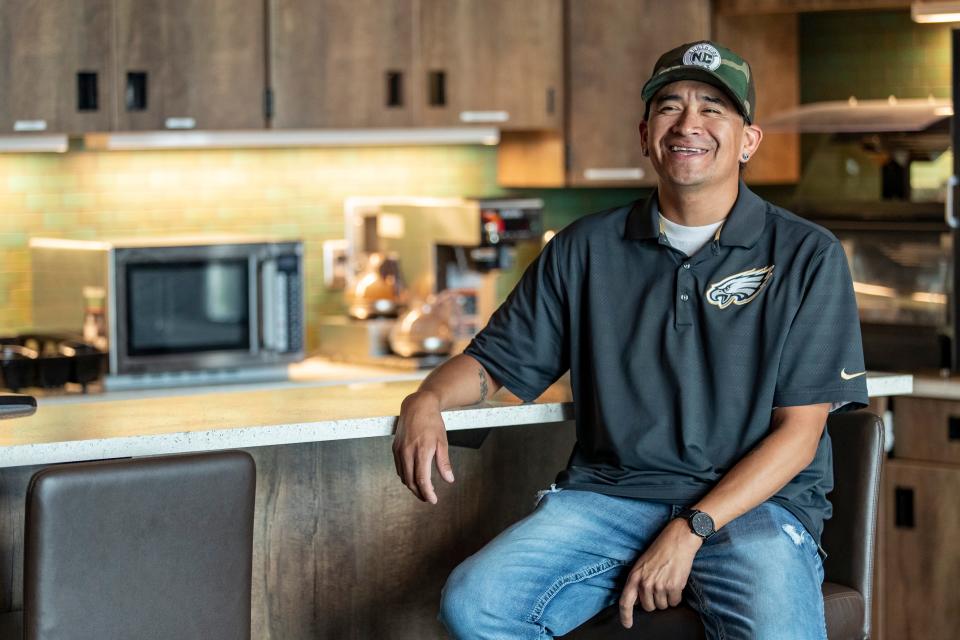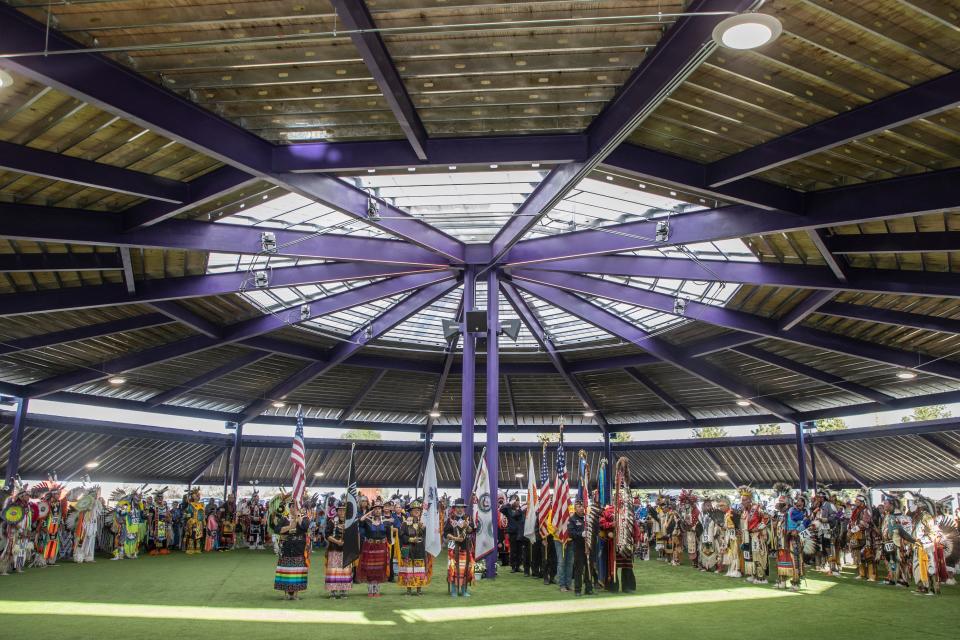Native Americans face a deadly drug crisis. How tapping into culture is helping them heal

BISMARCK, N.D. — A bashful Native American who thwarted death twice summoned his inner warrior during a summer powwow, dressed in purple regalia and long feathers.
Jasten "Jazz" Bears Tail, 36, immersed himself in the movement, a style called fancy dancing, at the event in the North Dakota town of Parshall on the Fort Berthold Indian Reservation. He stomped and twirled in sync with the pounding of the drums, symbolizing the heartbeat of his ancestors.
On the periphery, his 11-year-old son, Pistol Bears Tail, proudly watched his father's comeback. Jazz disappeared from competitions a couple of years ago while battling his addiction.
The disease, which also afflicted his father, nearly killed him twice, wrecked his marriage, pulled him from his children and shredded his confidence.
"With us natives, when we’re impure and out doing stuff we’re not supposed to do, our spirit leaves us," he said.
"There’s no life in you, no glimmer of hope in your eye. You’re pretty much a lost soul just roaming around."
Jazz, a descendant of the Hidatsa and Sioux tribes, sought treatment for drug addiction in Arizona and fought his way back. Now, he lives in Bismarck and mentors other Native Americans in treatment at the Good Road Recovery Center.
The Fort Berthold-based MHA Nation — members of the Mandan, Hidatsa and Arikara tribes — paid to build the residential recovery center and its transitional living facility, which use a culturally competent model that incorporates tradition and customs to help people heal.
A growing number of residents have sought treatment in this community, which has been inundated by drugs largely supplied by Mexican cartels that are flooding the U.S. every year with thousands of kilos of methamphetamines, heroin, cocaine and fentanyl.
"Many native families are suffering from generational abuse, eroding traditional values and destabilizing families" across the country, according to the National Congress of American Indians' website. "Inflated rates of substance abuse plague tribal communities."
In June, Jazz became the cultural specialist at the treatment center in Bismarck, about a two-hour drive southeast of the reservation. He brought knowledge of his culture, coupled with his experience going through 12-step addiction treatment.
"When we do the right thing, our spirit will come back to us," he said. "You get your strength back.
"I felt something greater than myself guiding me, an internal coach that I had been missing for a while.”
A place to heal and connect to culture
Addiction specialists and other health officials have recommended addressing patients' cultural histories and experiences in treatment for decades.
Yet, it's not incorporated consistently across the country, said Dr. Nzinga Harrison, chief medical officer and co-founder of Eleanor Health, which operates outpatient addiction treatment in several states.
"We're slowing marching in that direction," said the physician who has been practicing for two decades and is based in Atlanta. "There's been a lack of appreciation for how important it is …
"Culture and identity are the basis for discrimination. And discrimination is the basis for illness and drives disparities in who develops addiction, who gets treatment for addiction and who does well in treatment."
The Courier Journal spent two days at the Native American recovery center in Bismarck and several days on the Fort Berthold Indian Reservation this summer to learn about the tribes' widespread addiction and how they're including culture in treatment in the face of large-scale drug distribution.

Staff and clients ground themselves daily in the traditions of the MHA Nation, called the Three Affiliated Tribes. That includes starting the day with meditation.
"It helps them center," said Dr. Joy Froelich, a family physician of Arikara and German descent who serves as the center's director.
"With recovery, clients seem to have a lot of internal turmoil. We’re hoping bringing some culture can help them be more comfortable in finding who they are and where they need to go from here."
Since it opened in December 2018, Good Road has treated 185 Native Americans, Froelich said. That number has already more than doubled from last year, from 35 to 77 clients, and the center hopes to continue expanding.
During a guided morning meditation in a dimly lit conference room, participants closed their eyes and focused on clearing their minds and deepening their breath. They burned sage, cedar and sweetgrass, and used their hands to pull the smoke over their bodies as an act of purification called smudging.


"Smudging, it cleanses my mind," said Kyle Star, dressed in a navy Dallas Cowboys jersey and jeans.
"I ask for strength, courage and patience. I'm here to try to figure out what happened at the end of my sobriety to my drug use."
One at a time, they shared thoughts or worries. Some chose not to speak. The center provides anonymity to its clients, but Star allowed The Courier Journal to use his name to encourage others to get treatment.
As the meditation drew to a close, a woman prayed over a pot of water and poured it in cups so everyone could receive the blessing.


The center also offers classes for women on Native American traditions such as sewing quilts or long, colorful ribbon skirts. The men learn to stretch elk and deer hides over wood frames to make drums.
"I was blessed and honored to sit at the drum with my dad," Star said of past powwows at his father's side.
Star said he wants to relearn native songs sung during dances that convey stories of their ancestors' hardships and victories.
He and other men teamed with native women earlier this year to hoist towering cedar poles and plant them in the ground in front of the treatment center, wrapping them in canvas to form a large teepee.
Twice a month, they can brush and ride horses during off-site equine therapy.

And there are frequent sweats. Rocks, which symbolize their grandfathers, are placed on woodpiles at a dome-shaped lodge.
As the fire builds, participants go inside, symbolizing a return to the womb to be purified and reborn, said Tracy Burr, who has been sober for 37 years and is now the center's recovery services consultant.
The men and women speak, pray or sing.
"It's almost, in a sense, a confessional," Burr said.
A 32-year-old woman, who is fighting to get sober to return to her young daughter, said the steam is like the creator's breath. When the sweat lodge doors are open, she says the steam carries her prayers skyward to relatives who have died.
The center uses a traditional 12-step program centered on abstinence, adding medicines for some people who are detoxing. Treatment is also rooted in a reliance on a higher power.
For some, that means attending Bible classes and praying to God. Others view their higher power as the collective community of their tribe.
Jazz started work at the center as a recovery coach. In June, he was named the cultural specialist, meaning he teaches classes and must work to overcome his shy nature.
Though he dances in front of thousands, "It’s hard for me to talk in front of 10 people," he said.
But he's willing to face his fear in order to help others reconnect to their tribal customs and embrace sobriety.
The main lesson he hopes to impart: "It's never too late to find your identity."
‘Patients are going to demand it’
Reconnecting with culture and identity bolsters lasting recovery in the Native American community and beyond, addiction specialists say.
"The key to long-term recovery for Native and BIPOC (Black, Indigenous and People of Color) communities is a reaching back and a re-remembering those deepest roots of culture and tradition," said Dr. Gina Perez-Baron, past medical director for the Seattle Indian Health Board.
Perez-Baron, of Apache and Mexican descent, has treated patients with addiction for a decade and said trauma is the root cause of addiction, so it's key to understanding trauma in a historical context.
“As a Black woman, racism is a definitive part of my developmental history and everyday life in this country," Harrison said. "If I have a health care provider that cannot address the impact of racism on my life experience and health, (treatment) is less likely to be effective."
For members of more than 500 Native American tribes, that means understanding the effect of cultural genocide.
"We've known for a long time that it's extremely important to address people in their cultural context if you're going to treat addiction," said Dr. Chris Stewart, director of the addictions program at the University of Louisville Physicians Outpatient Center.
"It's about understanding, in a more deep way, the problems people have and what might be important to appreciate about their culture so you can provide more relevant recommendations and interventions for their treatment."
Stewart said this requires empathy and open conversation with patients, who may not share the same ethnicity, gender identification and religion with their doctors.
"It's not impassible, not a wall," Stewart said cultural differences. "But it's another barrier, and there are already tons of barriers to getting clean and sober."
Experts call this model, when the clinician strives to understand a patient's differing background, "cultural humility."
Perez-Baron said she witnessed the model's success when she treated patients in Northern Mexico by incorporating their own customs and traditions. She saw career criminals blossom into community leaders and family men.
The federal Substance Abuse and Mental Health Services Administration has long recommended addressing culture during treatment.
Yet Stewart said: "It's something that doesn't get implemented enough."
Doctors hope that changes as the deadliest addiction crisis in U.S. history converges with an increased awareness of racial disparities in health care.
"We're at a point where patients are going to demand it, and as we get more data, we're going to see that's where the (best) outcomes are," said Perez-Baron.
Doctors agree there needs to be a heightened focus on recruiting a diverse group of clinicians to reflect the communities they serve.
The MHA Nation's treatment center in Bismarck recruits members from its tribes, including those who have moved from the reservation. It also uses Native American staff at its sober living homes in Bismarck.
"As native people, our traditions are slowly getting lost," Jazz said. "So the more we can incorporate it, you start to see the clients rediscovering their identity.
"They’re getting that power back, of knowing who they are.”
‘My ancestors are dancing with me’
Jazz's turbulent journey from drug abuse and addiction to sobriety stretches back nearly two decades.
He remembers a drinking binge at age 18 that caused him to black out in a cornfield. After the blinding glare of police officers' flashlights jolted him awake, he spent the rest of the night in a detox cell.
It should have been a deterrent. Instead, other high school seniors thought it was a funny act of rebellion.
His drinking intensified when he and two buddies joined the U.S. Army. At home, he had smoked pot. On the military base in Albuquerque, New Mexico, he easily found the recreational drug ecstasy, known as molly, from a civilian worker moonlighting as a dealer.
Jazz's substance abuse went on for years, until he suffered congestive heart failure in 2018 at the age of 33.

Fluid from years of abusing methamphetamines and other drugs, including alcohol, swelled his heart to triple its normal size. Doctors prodded him into treatment.
He said he later suffered three or four relapses that nearly killed him.
Once, he woke up in a Bismarck hospital's intensive care unit after overdosing on oxycodone pain pills.
Two years ago, he overdosed on a fake oxycodone pill that contained fentanyl, a deadly opioid, while in a sober living home in Arizona. A housemate revived him with naloxone, a heroin and opioid antidote.
He went back to treatment in Phoenix on January 5 and has been sober since — and now lives closer to his three children in Bismarck.
Jazz knows he missed a lot of milestones — birthdays and holidays, his daughter's dance recital, his oldest son winning most valuable player honors at a youth basketball tournament in Albuquerque.
Now, he tries to make up for what he missed by taking each one out for a special day, like a Los Angeles Lakers' basketball game in Phoenix with Pistol.
"It's better," Pistol said. "I get to see him a lot more."


The night of Jazz's powwow comeback in the parking lot of the outdoor pavilion, Pistol helped him practice a special move requiring him to lean back, raise an arm and flick his wrist like he's shooting a basketball.
The 11-year-old, who used to spend hours on weekends playing video games, recently told his father he, too, wants to become a powwow competitor.
"He pretty much wants to do everything I do," the father said of Pistol. "I gotta always watch what I do. He’s always right there.”

Jazz saw the destructive power of addiction early on as his father, a "powwow rockstar," suffered from alcoholism. His father would sometimes sip from a flask mid-performance without missing a beat.
Jazz was 10 when his father was killed during a drunken brawl.
Though he is proud of his father, he wants to leave a different imprint. He quietly chats with other powwow participants about how life is better sober and how native dance helps ground him.
"This is where I’m supposed to be," Jazz said after a powwow.
"My ancestors are dancing with me."
Follow Louisville Courier Journal reporter Beth Warren on Twitter: @BethWarrenCJ
Help with addiction
Native Americans can find the federal Indian Health Service's online guide to finding addiction treatment, listed under "behavior health."
More information about the importance of cultural competence in addiction recovery can be found through the federal Substance Abuse and Mental Health Services Administration's online treatment improvement protocol.
Anyone struggling with addiction can find help through the Substance Abuse and Mental Health Services Administration's national helpline, 1-800-662-HELP.
Learn about the importance of culture in health care
The federal Substance Abuse and Mental Health Services Administration offers a resource guide on its website, samhsa.gov.
For organization leaders who want to teach their workforce about the importance of culture, Dr. Nzinga Harrison recommends starting with a short form called the PEDQ, Perceived Ethnic Discrimination Questionnaire and the Everyday Discrimination Scale.
This article originally appeared on Louisville Courier Journal: How Native Americans fight drug addiction with cultural competence

